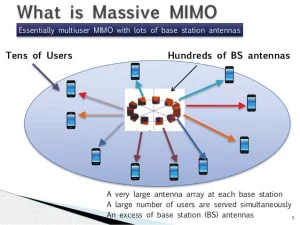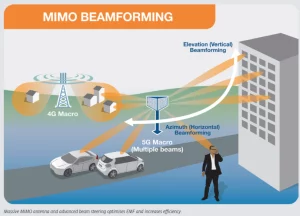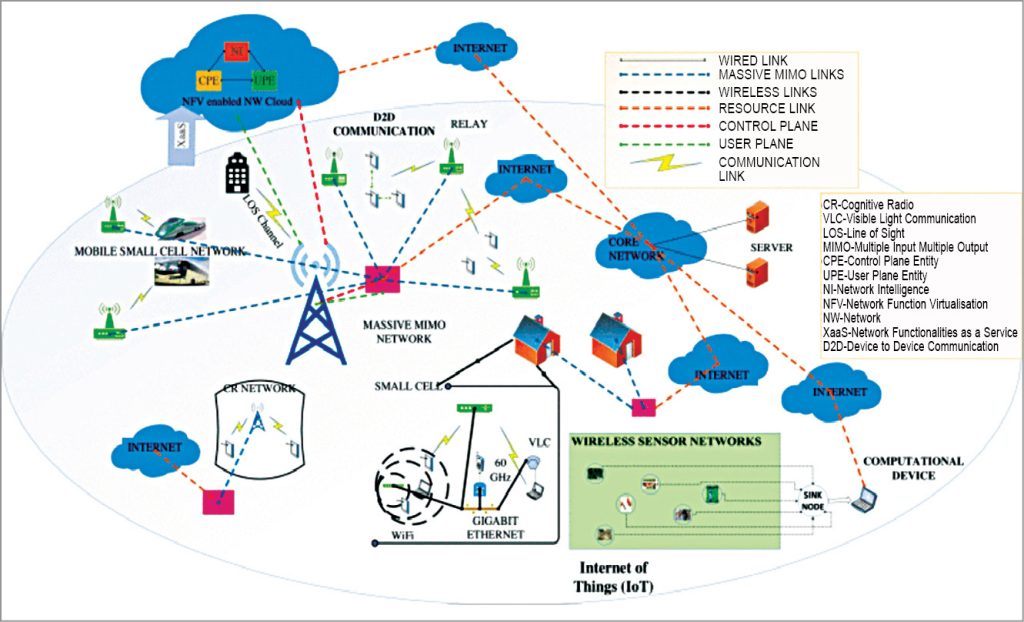The wireless communication landscape has been completely transformed by MIMO technology, providing a faster and more reliable data transfer experience. By utilizing multiple antennas at both ends of the transmission process, MIMO systems are capable of enhancing capacity while reducing interference in an unprecedented manner. This is particularly important when considering the high-speed connections with low latency required in 5G network development.

Massive MIMO systems represent another major advancement within this field, using a vast number of antenna elements to further bolster performance capabilities. These innovative systems offer unparalleled spatial diversity and beamforming capabilities that translate into higher throughput rates and coverage that is beyond compare. As society’s reliance on wireless connectivity continues to grow unabated, it seems almost certain that massive MIMO will play an absolutely critical role in meeting these needs.
Beamforming techniques have become essential components of modern-day MIMO technologies as they allow for smart antennas to focus energy toward specific directions rather than broadcasting uniformly in all directions. This translates into vastly improved signal quality alongside reduced interference from external sources. Depending on system requirements, beamforming techniques can be analog or digital; however, hybrid beamforming may provide optimal results across applications such as those found within 5G networks – leaving us pondering what other technological advancements await us just over the horizon?
The Benefits of Beamforming Techniques in MIMO Systems
Contents
- 1 The Benefits of Beamforming Techniques in MIMO Systems
- 2 Analog and Digital Beamforming: How They Work in MIMO Systems
- 3 Massive MIMO: Using a Large Number of Antenna Elements for Better Performance
- 4 Hybrid Beamforming: Combining Analog and Digital Techniques for Optimal Results
- 5 Using Beamforming for Networks and Future Wireless Communication Applications
- 6 Adaptive Beamforming: Adjusting Antenna Signals to Reduce Interference
- 7 Beamforming Antenna Arrays: How They Enable Multiple Antennas to Work Together for Optimal Reception and Transmitting.
The perplexing and bursty world of MIMO systems relies heavily on the deployment of beamforming techniques in wireless communication. The concept behind this technology is to direct signals towards specific directions, which results in better coverage and increased capacity. Interestingly, beamforming can be achieved using analog or digital techniques, or even a combination of both!

One significant benefit brought by beamforming is its ability to allow multiple antennas to work together as an array system. This innovative approach replaces one large antenna with several smaller ones, leading to more flexibility and improved performance. In massive MIMO systems where hundreds or thousands of antennas are used simultaneously, beamforming becomes critical for optimal reception and transmitting.
Digital beamforming has gained immense popularity due to its capability to adjust phase and amplitude values independently at each antenna element. As a result, greater control over signal directionality is possible while reducing interference from other sources. Analog and digital beamforming can also be combined (hybrid) for maximum efficiency by utilizing their respective strengths.
In conclusion, advanced technologies like MIMO beamforming will play a pivotal role in handling the increasing demands for wireless data transmission as 5G networks loom on the horizon. Today’s types of beamforming offer various advantages depending on specific use cases such as massive MIMO systems or wireless applications requiring high-speed data transfer rates over long distances – all thanks to sophisticated algorithms designed specifically around them! Rapid technological evolution within this field means we can anticipate further innovations that will enhance our ability to communicate wirelessly more efficiently than ever before using antenna arrays!
Analog and Digital Beamforming: How They Work in MIMO Systems
The bewildering world of MIMO systems is replete with arcane techniques that boggle the mind. Analog and digital beamforming are two such cryptic methods used to boost wireless communication. The former involves tweaking the phase and amplitude of a signal transmitted through an array, while the latter employs sophisticated algorithms to manipulate signals received by multiple antennas.
Enter hybrid beamforming, where both analog and digital techniques are melded together for optimal results. This amalgamation offers unparalleled flexibility in controlling interference and optimizing transmission quality in wireless communication systems that boast multiple antenna elements. Not only does this approach save on power consumption but it also bolsters overall system performance.
Adaptive beamforming is yet another perplexing technique utilized to adjust antenna signals based on environmental changes or interference from other sources. By dynamically adapting their transmissions under real-time conditions, MIMO systems can improve reception quality whilst mitigating external factors that may impede wireless communication performance. It’s these advanced beamforming techniques that allow operators to fine-tune their networks for better coverage, faster data speeds, and more reliable connections across a range of applications and use cases – all through an enigmatic lens!
Massive MIMO: Using a Large Number of Antenna Elements for Better Performance
The utilization of a massive MIMO system is an approach that has gained significant traction in recent years, specifically with the advent of 5G networks. Essentially, this type of smart antenna system employs a multitude of antennas to enhance wireless communication performance. By harnessing more antennas at our disposal, beamforming algorithms can be employed to direct signals towards specific users or devices.
A key benefit rendered by using a massive MIMO antenna setup is the ability to leverage multi-user MIMO (MU-MIMO) technology. This empowers multiple users to transmit and receive data concurrently on the same frequency band – which can considerably improve network capacity and alleviate congestion concerns. Furthermore, through beamforming techniques, narrowband beamforming becomes achievable with a massive MIMO system – thus elevating signal quality even further.
Both analog and digital beamforming methods are within reach when implementing a massive MIMO configuration. Analog beamforming involves manipulating phase shifts across different antenna elements to create directional beams aimed at designated users or locations; while digital beamforming entails utilizing sophisticated signal processing algorithms for individually tweaking signals from each antenna element before amalgamating them into one output signal. With such copious combinations possible via numerous available antennas, hybrid analog-digital systems often get deployed for optimal performance in real-world scenarios where interference may crop up between various channels being transmitted simultaneously through the base station’s transmitter chain – all while maintaining low latency levels during transmission times without sacrificing range coverage capabilities within its intended area of operation.
Hybrid Beamforming: Combining Analog and Digital Techniques for Optimal Results
The perplexing and bursting technique of hybrid beamforming is a merging of analog and digital beamforming that has taken the wireless communication world by storm. Its optimal results in MIMO communication systems are achieved through directing antenna patterns towards receivers or transmitters – using an array system. The combination of these two techniques allows for 5G requirements to be met while maximizing performance.
In recent times, the use of hybrid beamforming has gained immense popularity due to its ability to improve signal quality and reduce interference significantly. This improvement is possible because it optimizes the phase and amplitude of antenna signals at each port, giving better control over transmission directionality. Furthermore, this technique also enables more efficient use of available spectrum resources.
Adaptive beamforming systems can work with hybrid beamforming as it adjusts antenna signals based on changing environmental conditions such as movement or interference from other devices. In high data rate environments like 5G networks where low latency and reliability are required, hybrid beamforming offers massive benefits over traditional antennas without any directional capabilities.
In conclusion, the bursty nature of hybrid beamforming provides significant advantages when compared to both analog and digital beamforming techniques used in wireless communication systems like massive MIMO or 5G networks. Its effectiveness in controlling transmission directionality while reducing interference from other sources within range has been shown beyond doubt; further advancements in this area will only continue improving performance into the future as technology continues evolving rapidly!
Using Beamforming for Networks and Future Wireless Communication Applications
Have you ever heard of the fascinating technique known as beamforming? It has taken the wireless communication world by storm, particularly in the realm of 5G cellular technology. Essentially, this clever method involves some pretty nifty signal processing wizardry to tweak antenna signals and elevate both reception and transmission quality. Imagine an array of antennas working together like a well-oiled machine to create directional beams that hone in on specific users or devices. Mind-boggling stuff!
But wait, there’s more! One of beamforming’s most significant boons is its uncanny ability to reduce interference between different users or devices through downlink beamforming. This enables multiple antennas to transmit data simultaneously with minimal interference – resulting in better network performance and higher throughput rates for all involved parties. Without such a technique, many unfortunate souls would suffer from sluggish internet speeds due to pesky high levels of interference from nearby devices.
Now, let’s delve into digital and hybrid beamforming – two popular techniques used for massive MIMO systems boasting tons of antenna elements at their disposal. Digital beamforming flexes its muscle by employing complex algorithms that process signals digitally before transmitting them via individual antennas; meanwhile, hybrid beamforming combines analog and digital techniques for optimal results while reducing power consumption.
And if that wasn’t enough technological wonderment for one day – behold adaptive array systems! These cutting-edge gadgets have gained popularity among router manufacturers as they implement Wi-Fi beamforming capabilities via advanced algorithms adeptly adjusting antenna arrays’ signals based on feedback from user device location and movement patterns.
It should come as no surprise then that Beamforming will continue playing an essential role in future wireless communication applications such as 5G base station networks; thanks to more advanced antenna technologies emerging every day! By improving network efficiency while minimizing interference issues between various connected devices or users-beam forming works tirelessly toward creating seamless connectivity experiences across all types of mobile platforms without compromising speed or reliability standards set forth by industry leaders today!
Adaptive Beamforming: Adjusting Antenna Signals to Reduce Interference
The world of wireless communication systems is a labyrinthine realm, full of complex techniques and technologies that can leave even the most tech-savvy individual perplexed. One such technique is beamforming – an approach that employs multiple antennas to enhance performance. And among its various types, adaptive beamforming stands out as a powerful tool in reducing interference caused by signals coming from different directions.
But make no mistake – there’s more to this story than just one type of beamforming. Other solutions like receive beamforming, fixed beamforming network, linear beamforming and mm-wave beamforming are also available, each with their own set of benefits depending on specific application requirements. For instance, narrow-band systems may benefit from adaptive linear or fixed-beamformers while broadband systems may require wideband adaptive algorithms.
And yet even these advanced techniques pale in comparison to the wonders wrought by massive MIMO technology which utilizes hundreds or thousands of antennas for even more precise signal processing capabilities such as hybrid analog/digital precoding/combining and full digital precoding/combining. With all these tools at our disposal, it becomes clear that adaptive beamforming plays a pivotal role in achieving optimal performance through massive MIMO technology.
Looking ahead into the future of wireless communications reveals how important it is to keep researching new ways to improve our understanding of this field so we can better meet diverse communication needs across various industries and sectors. Adaptive Beam forming holds great promise since it allows us to dynamically handle interference problems without any prior knowledge about interfering sources – providing much-needed flexibility when radio frequency conditions rapidly change over time or between locations within a given area.
Beamforming Antenna Arrays: How They Enable Multiple Antennas to Work Together for Optimal Reception and Transmitting.
The perplexing and bursty world of wireless communication systems relies heavily on beamforming antenna arrays. These arrays, while seemingly simple in nature, have the ability to bring multiple antennas together in perfect harmony for optimal reception and transmission capabilities. The sheer power of these weights allows them to focus on specific directions with laser-like precision, improving signal strength tenfold and reducing any pesky interference.
But here’s the kicker: beamforming isn’t limited to just analog or digital systems – it’s a hybrid design that has taken the industry by storm due to its cost-effective approach without sacrificing results. A true marvel of modern engineering!
And let’s not forget about one of its most mind-boggling advantages: spreading signals from a broadcast antenna across an entire city block without increasing power consumption or radiation levels! It truly is like magic; each set of antenna elements provides more control over where signals are directed resulting in better coverage and higher data rates for all users involved.
With massive MIMO uses becoming more prevalent within wireless communication systems (including MIMO technology), imagine what wonders will come as even more antennas are added to each array! The future is bursting with possibilities!


